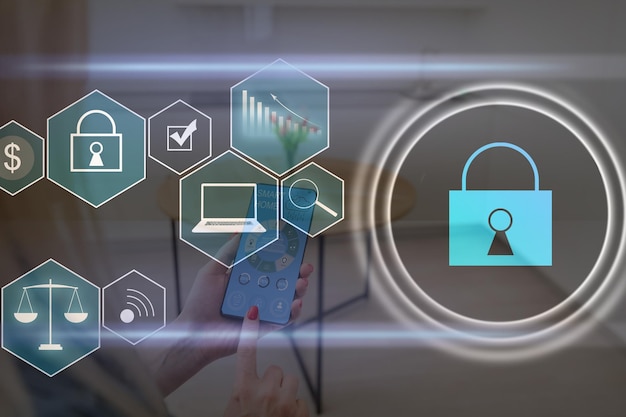In today’s digital age, cybersecurity has become a critical aspect of running a successful business. With the increasing reliance on technology and the constant threat of cyberattacks, it is essential for organizations to have robust cybersecurity solutions in place. This guide aims to provide you with a comprehensive understanding of cybersecurity solutions and how they can protect your business from threats and vulnerabilities.

Credit by Image: FreeImages
The Importance of Cybersecurity in the Digital Age
In the digital age, technology has revolutionized the way businesses operate. However, with this advancement comes the increased risk of cyber threats and attacks. Cybercriminals are continually finding new ways to exploit vulnerabilities in networks, systems, and applications. These attacks can lead to financial loss, damage to reputation, and even legal consequences. Therefore, it is crucial for businesses to prioritize cybersecurity and invest in robust solutions to protect their assets and sensitive information.
Understanding Cybersecurity Solutions

Cybersecurity solutions encompass a wide range of tools, technologies, and practices designed to protect digital systems from unauthorized access, data breaches, and other cyber threats. These solutions are essential for businesses of all sizes, as even a single breach can have severe consequences. By implementing cybersecurity solutions, organizations can ensure the confidentiality, integrity, and availability of their data and systems.
Common Cybersecurity Threats and Vulnerabilities
Before diving into the world of cybersecurity solutions, it is crucial to understand the common threats and vulnerabilities that businesses face in the digital age. Malware, phishing attacks, ransomware, and social engineering are just a few examples of the threats that can compromise the security of your business. Vulnerabilities can exist in various areas, including network infrastructure, operating systems, web applications, and employee practices. By identifying these threats and vulnerabilities, you can better assess your business’s cybersecurity needs and select the appropriate solutions.
Assessing Your Business’s Cybersecurity Needs
Every business is unique, and so are its cybersecurity needs. Before investing in cybersecurity solutions, it is essential to assess your organization’s specific requirements and risks. Conducting a thorough risk assessment will help you identify potential weaknesses and prioritize the areas that require immediate attention. This assessment should consider factors such as the nature of your business, the sensitivity of your data, regulatory compliance requirements, and the potential impact of a cyberattack. By understanding your specific needs, you can choose the right cybersecurity solutions that align with your business goals.
Types of Cybersecurity Solutions
![]()
The world of cybersecurity is vast, with various solutions available to address different aspects of digital security. Some commonly used cybersecurity solutions include antivirus software, firewalls, encryption, intrusion detection systems, and vulnerability scanners. Antivirus software protects against known malware threats, while firewalls act as a barrier between your internal network and the outside world. Encryption ensures that your data remains confidential, while intrusion detection systems monitor network traffic for suspicious activities. Vulnerability scanners help identify weaknesses in your systems that can be exploited by cybercriminals. Understanding the different types of cybersecurity solutions will help you make informed decisions when selecting the right tools for your business.
Choosing the Right Cybersecurity Solution for Your Business
Choosing the right cybersecurity solution for your business can be a daunting task, given the multitude of options available. However, by considering your specific needs, budget, and technical capabilities, you can narrow down your choices. It is essential to evaluate the features, functionality, and reputation of each solution provider. Look for solutions that offer real-time threat intelligence, regular updates, and reliable customer support. Additionally, consider scalability and compatibility with your existing infrastructure. Consulting with cybersecurity experts or seeking recommendations from trusted sources can also help you make an informed decision.
Implementing Cybersecurity Solutions: Best Practices and Considerations
Once you have selected the appropriate cybersecurity solutions, implementing them effectively is crucial. Start by creating a detailed implementation plan, including timelines, responsibilities, and milestones. Prioritize the most critical areas of your business and gradually expand your security measures. Consider involving your IT team or outsourcing to experienced professionals for a seamless implementation process. Regularly update and patch your systems and applications, as outdated software can be vulnerable to attacks. Lastly, establish clear policies and procedures and educate your employees on cybersecurity best practices to ensure their active participation in maintaining a secure environment.
Training and Educating Your Employees on Cybersecurity
While cybersecurity solutions play a vital role in protecting your business, your employees are often the first line of defense. Human error and negligence can lead to significant security breaches. Therefore, it is essential to provide comprehensive training and education on cybersecurity to all employees. This training should cover topics such as password hygiene, identifying phishing attempts, secure browsing practices, and the importance of software updates. Regularly reinforce these teachings through workshops, newsletters, and simulated phishing exercises. By creating a culture of cybersecurity awareness, you can significantly reduce the risk of successful cyberattacks.
Monitoring and Maintaining Cybersecurity Solutions
Implementing cybersecurity solutions is not a one-time task. Continuous monitoring and maintenance are necessary to ensure their effectiveness. Regularly monitor your systems for any suspicious activities or anomalies. Utilize security information and event management (SIEM) tools to detect and respond to potential threats in real-time. Stay informed about the latest cyber threats and vulnerabilitie, and keep your solutions up to date. Conduct periodic audits and penetration tests to identify any weaknesses in your security infrastructure. By proactively monitoring and maintaining your cybersecurity solutions, you can stay one step ahead of cybercriminals.
The Cost of Cybersecurity Solutions: Budgeting and ROI Considerations
Investing in cybersecurity solutions is a wise decision, but it is essential to consider the associated costs and expected return on investment (ROI). Budgeting for cybersecurity should be a priority, considering the potential financial and reputational damage of a cyberattack. Assess the costs of different solutions, including licensing fees, implementation expenses, and ongoing maintenance. Evaluate the ROI based on factors such as reduced risk, increased productivity, and compliance with regulatory requirements. Consider working with a cybersecurity consultant to conduct a cost-benefit analysis and make informed decisions regarding your cybersecurity budget.
The Future of Cybersecurity Solutions
As technology continues to evolve, so do cyber threats. The future of cybersecurity solutions lies in advanced technologies such as artificial intelligence (AI), machine learning (ML), and behavioral analytics. These technologies can help organizations detect and respond to emerging threats more efficiently. Additionally, the rise of the Internet of Things (IoT) presents new challenges and opportunities in terms of securing interconnected devices. As businesses become more interconnected and data-driven, cybersecurity solutions will need to adapt and evolve to meet the changing landscape of threats.
Conclusion: Protecting Your Business in the Digital Age
In conclusion, cybersecurity solutions are crucial for protecting your business in the digital age. By understanding the importance of cybersecurity, assessing your specific needs, and implementing the right solutions, you can safeguard your organization from cyber threats and vulnerabilities. Remember to prioritize employee training and education, monitor and maintain your cybersecurity solutions regularly, and budget for the associated costs. As the future of cybersecurity unfolds, continue to stay informed about emerging technologies and threats. By taking a proactive approach to cybersecurity, you can ensure the long-term success and security of your business in the digital age.


